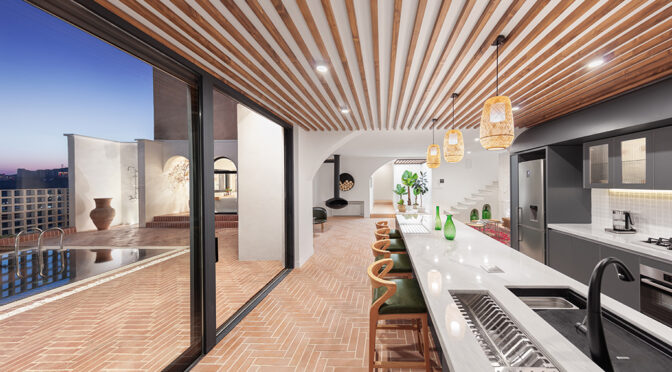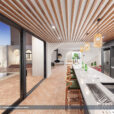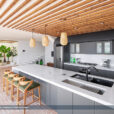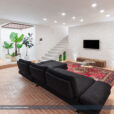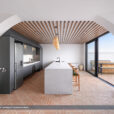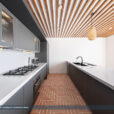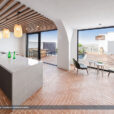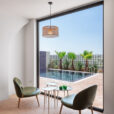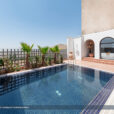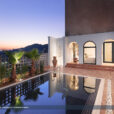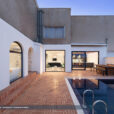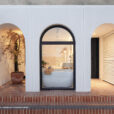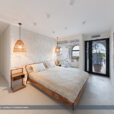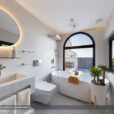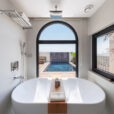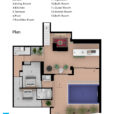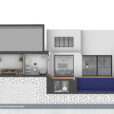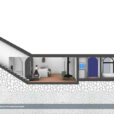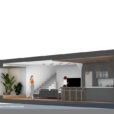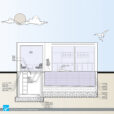تراسه
استودیو معماری شماره چهار (محمدیوسف صالحی، محمدصادق افشارطاهری)
موقعیت: شهر جدید پردیس، تهران، ایران
تاریخ: ۱۴۰۱
مساحت: ۲۰۰ مترمربع
وضعیت: ساختهشده
کارفرما: شهرزاد جلالی
تیم طراحی: آرش فقیهی، علی شریفپور
سازه: ایمان حضرتی
اجرا: استودیو معماری شماره چهار
مدیر اجرایی: امیرعلی تبریزی
گرافیک: محیا عمویی، فرشید نصر آزادانی
عکس: پیمان امیرغیاثوند
پروژه تراسه در شهر جدید پردیس واقع شده است، شهری در دامنه کوههای البرز. بر اساس طرح جامع این شهر، تعدادی از ساختمانها به شکل پلکانی و به حالت ویلاـآپارتمان طراحی و ساخته شدهاند که به این نوع از آپارتمانها «تراسه» گفته میشود. یکی از همین تراسهها برای بازطراحی به ما سپرده شد که یک واحد دوخوابه شامل ۱۴۰ مترمربع زیربنای مفید به همراه ۷۰ مترمربع تراس بود.
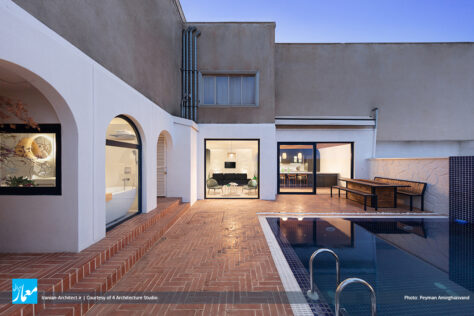
خواسته اصلی کارفرما داشتن یک تجربه فضایی متفاوت از خانه، و فضایی دور از شلوغی و هیاهوی شهر بود، و اینکه فضای پروژه فضایی دورگه میان ویلا و آپارتمان، و برخوردار از حس و حالی نزدیکتر به طبیعت باشد. به لحاظ عملکردی نیز کارفرما خواستار سرویس مستقل برای یکی از اتاقها بود. بدینترتیب، اولین چالش پروژه، ایجاد فضای اضافه برای سرویس یکی از اتاقها بود تا آن اتاق بتواند کارکردی مستقل داشته باشد.
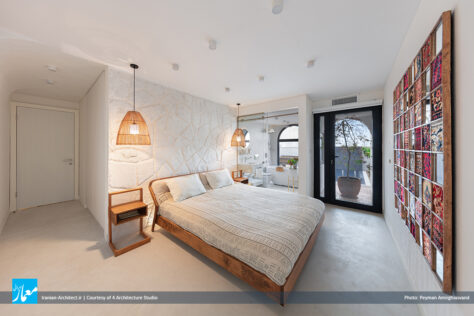
چالش بعدی که باید همسو با خواستههای کارفرما، راهحلی برایش میاندیشیدیم، مشکلات سازهای بنا بود که خارج از کنترل ما بود. ما میبایست از یکسو به خواستههای کارفرما و برنامه جدید پروژه پاسخ منطقی میدادیم، و از سوی دیگر، با دغدغه بهوجودآمده از دل سازه قدیمی مجتمع، به تعاملی منطقی میرسیدیم. بدینترتیب، وجود بادبندهای مورب فلزی که حائل دیوار به سقف بودند و در جایجای پروژه دیده میشدند، ما را به سمت بهکارگیری قوسهایی با زاویه مشابه این بادبندها، و ایجاد یک وحدت فرمی در کلیت طرح هدایت کرد.
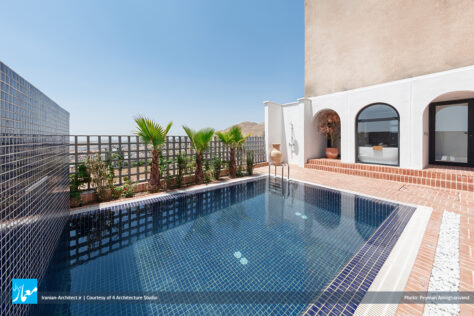
در اواسط پروژه، به پیشنهاد ما، کارفرما با احداث یک استخر چهارفصل مناسب در محوطه تراس موافقت کرد. پس از بررسی موضوع با مشاوران سازه و تایید همه کارشناسان مبنی بر اصولیبودن احداث استخر، وارد مرحله طراحی آن شدیم. ما سه کد ارتفاعی مختلف در ارتباط بین فضاهای داخلی و تراس داشتیم و برای اینکه به یک طرح منسجم در پاسخ به همه چالشها و نیازهایمان برسیم، نیازمند یک راهحل عملکردی برای اتصال بهینه فضاهای درون و بیرون به یکدیگر بودیم. راهحل ما برای این منظور، همسانسازی تراز ارتفاعی نشیمن، آشپزخانه و تراس (که شامل استخر و ملحقات آن نیز میشود)، به منظور متصلشدن فضای مسقف و فضای باز، و ایجاد یک فضای رویداد همگن بود.
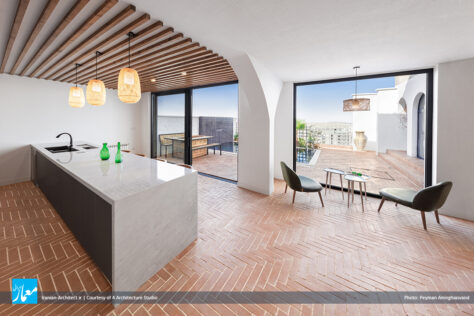
استفاده از گیاهان ناحیه گرمسیری در فضای داخلی و زدودن آلایش از فضا؛ تامین نور طبیعی حداکثری با در نظر گرفتن بازشوهای بزرگ، و بهرهبردن از چشمانداز شهر و تراس در فضای نشیمن و آشپزخانه؛ و تامین و تغییر ریزفضاهای مورد نیاز و ایجاد یک فضای منسجم با سهولت ارتباط میان این فضاها، از دیگر مواردی بود که در طراحی پروژه مورد توجه قرار گرفت.
پروژه تراسه برخاسته از یک ایده آوانگارد نیست؛ محصول افکار هنرمندانه یک معمار هم نیست؛ این پروژه پاسخی است مماس با مرز محدودیتها و اختیارات حوزه ساخت، برای تامین نیاز کارفرما به یک بنای ییلاقی و مناسب اسکان موقت در آخر هفته. حاصل این بازطراحی در نهایت، تبدیل یک فضای منفصل اندرونیـبیرونی به یک فضای رویداد زندگی و متفاوتتر از «خانه» است، فضایی دورگه میان «ویلا» و «آپارتمان».
Terrace
4 Architecture Studio (Mohammad Yousef Salehi, Mohammad Sadegh Afshar Taheri)
Location: Pardis, Tehran, Iran
Date: 2022
Area: 200 sqm
Status: Completed
Client: Shahrzad Jalali
Design Team: Arash Faghihi, Ali Sharifpour
Structure: Iman Hazrati
Construction: 4 Architecture Studio
Construction Manager: Amir Ali Tabrizi
Graphic: Mahya Amouei, Farshid Nasr Azadani
Photo: Peyman Amirghiasvand
The Terrace project is located in the new city of Pardis, a city on the slopes of the Alborz mountains. According to the master plan of this city, a number of buildings have been designed and built in the form of stairs and villa-apartments; This type of apartments is called “Terrace”. One of these Terraces was referred to us for redesign, which was a two-bedroom unit containing 140 square meters of built space along with 70 square meters of terrace.
The client’s main demand was to have a different spatial experience from house, and a space away from the hustle and bustle of the city, and that the space of the project should be a hybrid space between a villa and an apartment, and have a feeling closer to nature. Functionally, the client needed one of the rooms to be re-designed with an equipped master service. Therefore, the first challenge of the project was to create additional space for the bathroom of one of the rooms, so that room could function independently.
The next challenge for which we had to find a solution per the client’s demands, was the structural problems of the building that were beyond our control. On the one hand, we had to give a logical response to the demands of the client and the new project’s program, and on the other hand, we had to reach a logical interaction with the concern arising from the old structure of the complex. Therefore, the presence of diagonal metal braces that were a barrier between the wall and the roof, and were seen everywhere in the project, led us to use arches with the same angle as these braces, and to create a formal unity in the whole design.
In the middle of the project, with the proposal of the design team, the client agreed to build a suitable four-season swimming pool in the terrace area. After reviewing the issue with structural consultants and confirming all the experts that the construction of the pool is in principle, we entered the design phase. We had three different height codes in the connection between the indoor spaces and the terrace, and in order to reach a coherent plan in response to all our challenges and needs, we needed a functional solution to optimally connect the indoor and outdoor spaces. Our solution for this purpose was to align the height level of the living room, kitchen and terrace (which also includes the pool and its accessories), in order to connect the closed and open space, and create a homogeneous event space.
Using tropical plants in the interior and and minimizing the space; providing maximum natural light by using large openings, and taking advantage of the city and terrace views in the living room and kitchen; and providing and changing the required micro-spaces and creating a coherent space with ease of communication between these spaces, were among the other things that were taken into consideration in the design of the project.
The Terrace project is not an avant-garde idea; It is not the product of the artistic thoughts of an architect; This project is a tangential response to the boundary of the limits and powers of the construction field, to meet the client’s need for a bungalow suitable for temporary weekend accommodation. The result of this redesign is finally transforming a separated internal-external space into a space for life events, and different from “house”, a hybrid space between “villa” and “apartment”.

